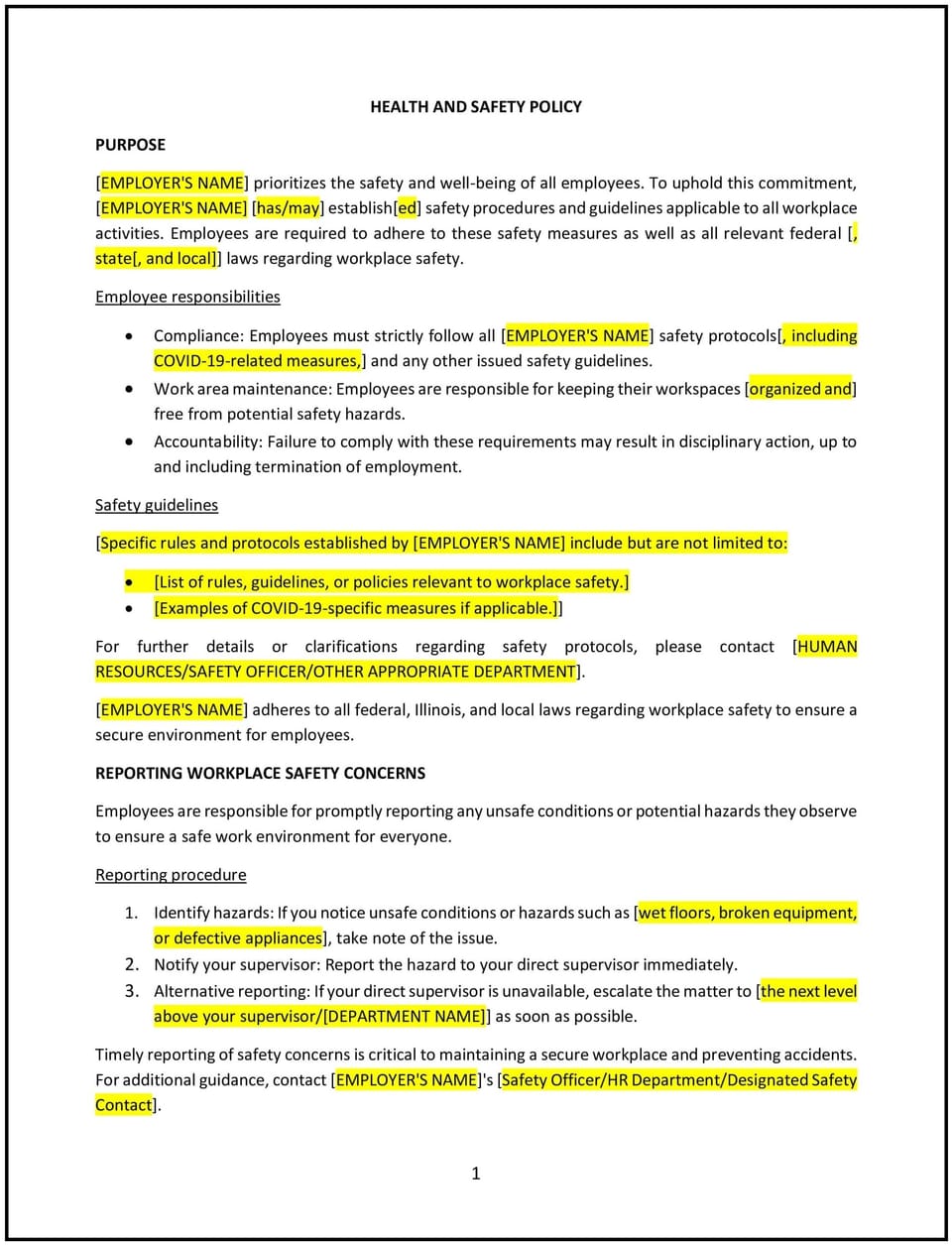Health and safety policy (Illinois): Free template

Health and safety policy (Illinois)
This health and safety policy is designed to help Illinois businesses maintain a safe and healthy work environment for employees. It outlines procedures for identifying hazards, implementing safety measures, and promoting compliance with Illinois laws, such as the Illinois Occupational Safety and Health Act (IOSHA).
By adopting this policy, businesses can reduce workplace risks, protect employees, and improve compliance with legal requirements.
How to use this health and safety policy (Illinois)
- Identify potential hazards: Conduct regular assessments to identify workplace hazards, such as unsafe equipment, chemical exposure, or ergonomic risks.
- Establish safety procedures: Implement safety protocols for handling equipment, hazardous materials, and emergency situations.
- Assign responsibilities: Designate roles for safety officers, managers, and employees to ensure accountability for health and safety.
- Provide training: Offer regular training on workplace safety, emergency procedures, and proper use of equipment.
- Address incident reporting: Establish a process for employees to report accidents, injuries, or unsafe conditions promptly.
- Promote compliance: Ensure all safety practices align with IOSHA and other Illinois-specific regulations.
- Conduct inspections: Schedule routine safety inspections to identify and resolve potential risks.
- Monitor performance: Regularly review the effectiveness of safety measures and update them as needed.
Benefits of using this health and safety policy (Illinois)
This policy provides several benefits for Illinois businesses:
- Protects employees: Reduces the risk of workplace injuries and illnesses by maintaining a safe environment.
- Enhances compliance: Aligns with Illinois safety regulations, minimizing legal and financial risks.
- Improves productivity: Supports a healthy workforce, reducing absenteeism and downtime.
- Builds trust: Demonstrates the company’s commitment to employee well-being.
- Encourages accountability: Establishes clear roles and responsibilities for workplace safety.
Tips for using this health and safety policy (Illinois)
- Communicate the policy: Share the policy with employees during onboarding and include it in the employee handbook.
- Train regularly: Provide ongoing safety training to ensure employees understand procedures and know how to respond to emergencies.
- Encourage reporting: Foster a culture where employees feel comfortable reporting hazards or unsafe conditions without fear of retaliation.
- Use signage: Display clear safety instructions and hazard warnings in the workplace.
- Update regularly: Revise the policy to reflect changes in Illinois laws, workplace conditions, or new safety requirements.
Q: What is the purpose of this policy?
A: The policy aims to maintain a safe and healthy work environment by outlining safety procedures and promoting compliance with Illinois regulations.
Q: Who is responsible for workplace safety?
A: Safety is a shared responsibility, with managers, employees, and designated safety officers accountable for maintaining a safe environment.
Q: How are workplace hazards identified?
A: Regular assessments and inspections are conducted to identify and address potential risks.
Q: What training is provided under this policy?
A: Employees receive training on safety procedures, emergency responses, and proper use of equipment to minimize risks.
Q: How should employees report safety concerns?
A: Employees should report hazards or unsafe conditions to their manager or a designated safety officer immediately.
Q: What happens if an incident occurs?
A: Incidents are documented and investigated promptly to determine causes and implement corrective measures.
Q: How often is this policy reviewed?
A: This policy is reviewed annually or whenever significant changes occur in Illinois laws, workplace conditions, or safety standards.
Q: Does this policy apply to remote employees?
A: Yes, remote employees are encouraged to maintain a safe and ergonomic workspace to support their health and well-being.
This article contains general legal information and does not contain legal advice. Cobrief is not a law firm or a substitute for an attorney or law firm. The law is complex and changes often. For legal advice, please ask a lawyer.


